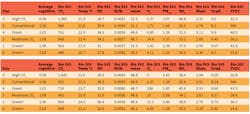In October 2015, a report1 detailing a study designed to evaluate the effect of ventilation, volatile organic compounds (VOCs), and carbon dioxide (CO2) on workers’ cognitive performance was published. The researchers used a reportedly objective measure, as opposed to most earlier studies’ occupant opinions/responses, to evaluate the benefits of increased ventilation.
In November 2014, 24 professionals (architects, designers, programmers, engineers, creative marketing professionals, managers) spent six full work days (9 a.m. to 5 p.m.) performing their normal work activities in two nearly identical environmentally controlled office spaces at the Willis H. Carrier Total Indoor Environmental Quality Laboratory at the Syracuse Center of Excellence for Environmental and Energy Systems (SyracuseCoE) in Syracuse, N.Y. During the experiment, they were exposed to various simulated building conditions:
• Day 1: “Green” (low VOC concentration) with enhanced ventilation (dubbed “Green+”).
• Day 2: Moderate level of CO2 independent of ventilation.
• Day 3: High level of CO2 independent of ventilation.
• Day 4: Green.
• Day 5: “Conventional” (high VOC concentration).
• Day 6: Green+ (same as Day 1).
At the end of each day, the researchers used the Strategic Management Simulation software tool to test the study participants’ working effectiveness.
The researchers found cognitive scores were on average 61 percent higher on the Green day and 101 percent higher on the two Green+ days than on the Conventional day.
If the results of the study are scientifically valid, they could lead to major modifications of current HVAC/ventilation design practices.
The key data from the study appear in Table 2 of the study report. A reorganization of that data (Table 1) raises questions about whether the data support the conclusions in the report or any firm conclusion at all.
TABLE 1. Reorganization of data in Table 2 of test report1 (except lb/lb, which were calculated from temperature and relative humidity).
Table 1 separates the data by room and orders them according to cognitive-test results. The patterns, to the extent there are any, are the same for the two rooms. The question is whether the data reflect any valid trends or cause-and-effect relationships.
Consider:
• For the Conventional test (Day 5), VOC levels were 10 to 30 times higher than they were for any of the other tests, raising the question whether any conclusions can be drawn from such a limited sample. With only one very high data point per room, the VOC data do not preclude the possibility that other factors accounted for the difference in cognitive-test results.
Interestingly, excluding the Conventional test, a comparison of Day 1 Green+ results with high-CO2 (Day 3) results shows approximately 100 percent better cognitive performance in the Green+ rooms despite the presence of close to 50 percent more VOCs. Is anyone prepared to say increasing VOCs increases cognitive performance?
• At first glance, there appears to be a pattern of increased cognitive performance with decreased levels of CO2. However, the data for moderate CO2 (Day 2) interrupt the pattern, raising a question as to whether there is a cause-and-effect relationship. At most, there are only enough data to identify the relationship between CO2 and cognitive performance as an area suitable for further study.
• The relationship between temperature and cognitive performance is just as strong as the one between CO2 and cognitive performance. If an analyst can exclude the moderate-CO2 (Day 2) data point or allow it as an anomaly in an effort to establish a relationship between CO2 and cognitive performance, he or she must do the same with the Day 1 Green+ data point. In that case, the data show reducing temperature increases cognitive performance. Based only on my own feelings, any such trend has a lower limit—comfort could become a distraction at temperatures much below the Day 6 Green+ temperature of 20.7°C (69.3°F) in Room 502.
• The ozone data are interesting. Despite the presence of significantly more ozone, cognitive performance was 60-percent better on the Green day (Day 4) than on the Conventional day. Cognitive performance was significantly better even on one of the Green+ days (Day 1), despite more ozone than on the Conventional day. Is anyone prepared to say we should ozonate our rooms? Perhaps there was an odor factor—either the odor of the ozone or the inability of the ozone to reduce odors—at play.
One might expect low VOCs to accompany high ozone (based on ozone oxidizing VOCs), but the data do not show that relationship.
• The only consistent pattern in the data seems to be increased cognitive performance with decreased relative humidity. The data cover a fairly small range of relative humidity and similarly small range in temperature, so any proposed relationship between relative humidity and cognitive performance is hardly conclusive.
The researchers should be commended for their efforts to create an objective measure for such an important issue, which heretofore has been measured only subjectively. At the same time, thoughts such as the ones presented here challenge the conclusions in the research report. At the very least, further testing and evaluation seems in order before the indoor-air-quality community launches a missile that might prove to be unguided.
Reference
1) Allen, J.G., MacNaughton, P., Satish, U., Santanam, S., Vallarino, J., & Spengler, J.D. (2015, October 26). Associations of cognitive function scores with carbon dioxide, ventilation, and volatile organic compound exposures in office workers: A controlled exposure study of green and conventional office environments. Environmental Health Perspectives. Retrieved from http://ehp.niehs.nih.gov/15-10037/
A longtime member of HPAC Engineering’s Editorial Advisory Board, Kenneth M. Elovitz is an engineer and the in-house counsel for Energy Economics Inc. His knowledge of and experience with HVAC, electrical, and life-safety systems allows him to understand system function and performance, including interactions among disciplines. He is an adjunct instructor in the Architectural Engineering program at Worcester Polytechnic Institute.
Did you find this article useful? Send comments and suggestions to Executive Editor Scott Arnold at [email protected].











